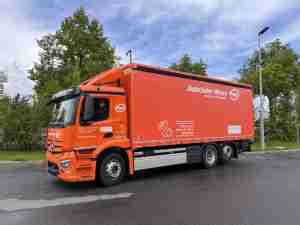DHL, which handles numerous shipments of rare and wild animals each year, has been working closely with the zoos and zookeepers involved in the transport for two months to plan every aspect of the shipment. More than 50 people have been involved in researching and planning for the move, managing numerous unique factors that must be considered, including crate specifications, jaguar weights, US Customs clearance requirements, US Fish and Wildlife Service requirements, in-flight temperature conditions, and food and water needs.
"Just like all of the shipments we handle, DHL is taking great care and precautions with Bebeto, Nieve, their son, and Jorge to ensure that everything goes smoothly during their journey, and that they arrive at their new homes safely, in good shape, and with minimal stress," said Joe Collopy, director of network capacity utilization for DHL. Collopy, who has regularly coordinated DHL's animal shipments for zoos and other institutions since 1995, led the DHL team responsible for the move. "The two most important elements of successful animal transports are research and preparation. We gather as much information about the specific animal being transported; and then we look at the transport from every angle -- beginning to end -- to ensure that the move runs like clockwork."
Wild jaguars in the area around Santa Cruz, Bolivia, are considered a menace to the local livestock, and are often captured and placed with the Santa Cruz Zoo. Bebeto, Nieve and Jorge were placed in this zoo, where the offspring of Bebeto and Nieve, the youngest, was later born in captivity.
From Miami, DHL transported the jaguars to its hub in Cincinnati, from where they flew on separate aircraft to their final destinations at the Fort Worth, Denver and Woodland Park Zoos. All three zoos are part of the Jaguar Species Survival Plan that works toward maintaining a genetically healthy population of jaguars in zoos, and focuses on raising awareness and educating visitors about jaguars and ecosystem conservation. The Jaguar Species Survival Plan, a program of the American Zoo and Aquarium Association that is dedicated to the long-term management and conservation of the jaguar, coordinated and planned the relocation of these four jaguars to new homes at the three US zoos through contacts in field conservation in Bolivia.
"Transporting animals is a big part of my job at DHL, but it's just one aspect of what we do as a company," added Joe Collopy. "Whether you're shipping endangered jaguars, or something that's less exotic but equally important to you or your business, DHL can help. We go 'above and beyond' for all of our customers - whether they're an individual, a small business, a FORTUNE 500 company, or a zoo."
The four jaguars traveled in specially constructed individual crates made of welded aluminum, provided by the zoo in Santa Cruz, Bolivia, where they were currently in residence. Each crate measures approximately 61"x 37"x 29" and weighs approximately 300 lbs with the jaguar inside. The cats, ranging in age between three and seven years old, were escorted throughout their journey by handlers from each of the zoos that will become their new homes in the US.
The crates carrying the cats were secured with TSA-certified pallets, nets, and straps during transport, and loaded onto forward positions onboard the aircraft to provide access as needed to the handlers during the flight. The loading position was also designed to minimize the time spent by the jaguars on the aircraf









